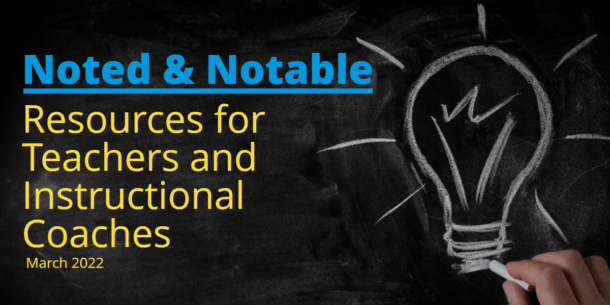Resources for Teachers and Instructional Coaches – March 2022

Did spring break keep you from staying up-to-date on recent resources for teachers and instructional coaches?
Not to worry; spring has sprung and we’re blooming with this month’s curated resources for teachers and coaches.
This edition of noted and notable content for educators includes how to say “yes” to a sustainable workload, best practices for family engagement, and creating a positive school culture.
Here are our top picks for the Mar. 2022 reads you shouldn’t miss. Read on for the highlights, article links, and related content.
Saying “yes” to sustainable teacher work means saying “no”
Teachers can take on too much work at school. Coaches often end up with “other duties as assigned.”
This Edutopia post discusses turning down requests from colleagues in order to set healthy work boundaries. There are ways to say “no” to this extra work on your plate politely yet firmly.
Here are three strategies:
Just Say It: Saying no can mean literally saying “no” to a task, but it can also include clarifying your role at school or bringing in context for setting a limit.
Take a Pause: Saying no can sometimes be nerve-wracking due to the pressure to respond right away, writes Venet. She recommends slowing things down to give yourself some space to think through a request.
Suggest an Alternative: Sometimes the best approach is to say, “No, I can’t do that… but I know who can,” Venet writes. “Seeing yourself as a bridge-builder can help you say no.”
Read the full post at Edutopia for more about these resources for teachers to turn down extra work: Phrases You Can Keep Handy to Say ‘No’ Clearly
Leaders, are you working on taking things off teachers’ plates? Check out this blog post with ideas for school initiatives you should stop.
Resources for teachers to improve communication for stronger family engagement
Important resources for teachers often include how to improve their communication with students’ families. That was the topic at a recent SXSW EDU panel.
This article from K-12 Dive outlines four best practices for communicating and engaging with families.
Listening to your school community. It’s key to spend time identifying the experiences and needs of families … While the focus is typically on families, student focus groups can also be a valuable tool for improving family engagement
Don’t assume how families communicate. Find out the ways they currently and would like to receive information from the district.
Improving language translation. Delport advised against districts relying on Google Translate for family engagement and communication. In her district, a translator writes school communications, and the translated message is then sent to another staff member who ensures it uses colloquial language with parents.
Navigating community climate challenges. It’s crucial to express more empathy. There’s a balance in striking a tone of empathy and being transparent about such major district decisions.
Read more at K-12 Dive: 4 best practices school communication experts are embracing to improve family engagement
Need more resources for teachers about communicating about student absences? Check out this post about improving student attendance through parent communication.
Positive school culture might mean flipping the script
Change in a school or district often happens without teacher input. This article for coaches and school leaders describes this as the wrong way to approach change and urges a different order of operations to get more teacher buy-in. This means more consensus-building.
If we want to support change productively, we must make time for discussions that support consensus building with our teachers and build a culture of shared decision-making.
Often, decisions are made top-down because planning is done by school leaders and coaches during the summer. But this leaves teachers out of the equation.
Unfortunately, the rhythm of the school year and its inherent approach to planning for change leaves our teachers out of the loop. We have to resist the order of operations we are used to and find ways to engage teachers in the reflection and planning discussions that map out the work for the academic year.
Meaningful change that includes teachers in the process also requires thoughtful conversation. This may mean more discussions where teachers can look at data and have their own reflections.
- Discussions can be structured as simple protocols that give our teachers the opportunity to engage in change conversations. These discussions can happen in small, facilitated groups and the data can be used as part of the planning process for the upcoming academic year. Consider the questions below:
- What is working well?
Where is there room for improvement?
What does the research recommend?
What should be our next steps?
Read more about the suggestions: Creating a Positive School Culture Requires Building Consensus
School leaders looking to improve school culture also need to look at their teacher survey data. Check out this post about strategies for building positive school culture.
Missed last month’s edition of resources for teachers and coaches? Catch up on our Feb. 2022 top resources for teachers and coaches!
